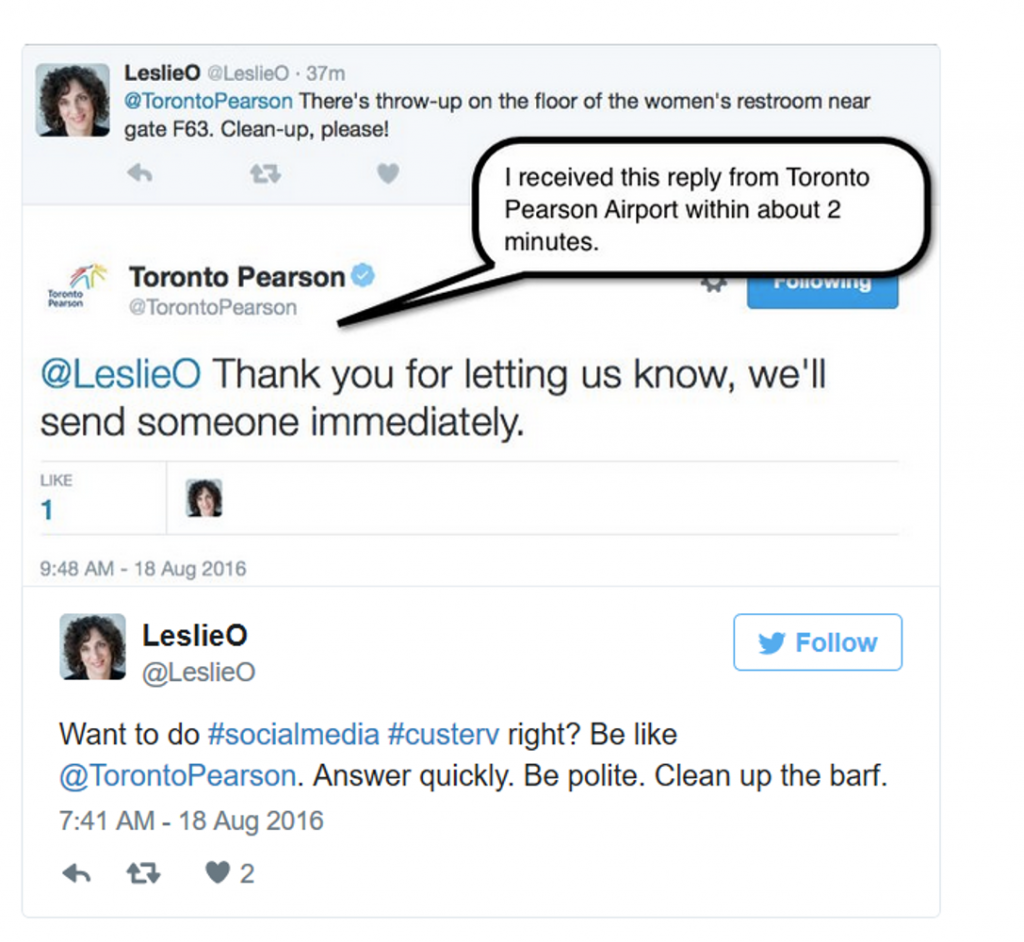Imagine you had to contact TSA.
That’s the Transportation Security Administration, the government agency. The agency that’s been blamed for long lines and missed flights.
Surprisingly, you’d do well to use Twitter if you need to contact TSA.
I recently had an issue where I wasn’t receiving TSA Pre-Check, even though I’m enrolled in the program. I sent a direct message via Twitter to @AskTSA. My message included my known traveller number and the airline’s record locator for my itinerary (two essential pieces of information I knew they’d need.)
Within an hour, I received a helpful response from John at @AskTSA. Better yet, my problem was solved.
John had discovered the travel agent who booked my flight had made a typo on my birthdate. He contacted the airline for me and gotten the problem fixed. All I had to do was re-print my boarding pass and I’d get to sail through the pre-check expedited screening line at the airport.
Twitter isn’t my preferred channel for this sort of thing. But, I know from previous experience that @AskTSA is very responsive and helpful.
This example highlights why letting customers contact you via whatever channel they want is nonsense. (My preferred channel would have been email.) There’s a better way that will leave them much happier.
The Resource Management Challenge
Imagine a contact center that receives 1,000 contacts per day. Here’s a hypothetical (but fairly realistic) breakdown of those contacts:
- 50% phone
- 30% email
- 15% chat
- 10% Twitter
- 5% online community
- 5% other
That’s 500 phone calls per day and 300 emails. And, those 10 percent of contacts from Twitter pencil out to 100 contacts per day. It’s a decent amount.
Now, consider how you would manage these channels. You’ll need to consider a few things:
Hiring. Can you hire people who are skilled in all channels or will you need to create separate hiring profiles?
Training. Do you have a training program in place for handling each channel?
Scheduling. Can you put the right people in the right place at the right time for each channel?
Technology. Does your contact center technology solution effectively support all of these channels, or do you need to acquire additional resources?
These issues are tough to manage for one or two channels. It gets even harder the more channels you add to the mix.
The reality is lower-volume channels often get short-changed when it comes to these issues. For instance, a 2016 study from Execs in the Know revealed that only 64 percent of organizations provide their social media team with training.
So, each time you add a new channel, you dilute the resources you have available to support all channels.
The Importance of Trade-Offs
In their book, Uncommon Service, authors Frances Frei and Anne Morriss lay out a compelling argument for making trade-offs in order to deliver outstanding service.
Southwest Airlines is a prime example.
The airline is consistently one of the top rated carriers for customer service. They have legions of adoring fans. Look closely, and you’ll also see things that Southwest does worse than other airlines.
- No assigned seats.
- Dirtier planes (they don’t use cleaning crews between flights)
- No first class or premium economy seats
Southwest succeeds despite these limitations because the company realizes the majority of their customers are very happy to live with them in return for what Southwest does do well:
- Low fares
- Convenient flights
- Friendly employees
Let’s go back to customer service channels and apply the same logic.
Most companies can’t provide amazing service via every channel under the sun. But, they can serve their customers at a high level if they concentrate on just a few.
Notice how TSA keeps things simple:
What Customers Really Want
Customers really want low friction.
My friend, Leslie, was recently traveling through Toronto’s Pearson airport when she noticed vomit outside the restroom. It was a hazard (not to mention disgusting), so Leslie decided to report it.
She used Twitter.

I asked her why she used Twitter. It seemed an odd choice to me at the time, but Leslie’s explanation made perfect sense.
“I didn’t see a janitor. I didn’t want to tell an airline employee because it’s not their job. Thus, my tweet.”
Keep in mind that Leslie was a busy traveler who wanted to alert the airport’s janitorial staff to the issue but not spend a lot of time doing it. She naturally chose the channel she felt would be both easy and effective.
Studies show that customers frequently make these sort of calculations. People often look for self-service options first because they seem easier. Channels like the phone are increasingly becoming a fall-back option when the customer’s first choice was unsuccessful.
Choosing Which Channels to Service
Ask yourself three questions before you add a new channel to your growing mix.
- Is there enough demand?
- Can you serve your customers effectively?
- Can you serve your customers consistently?
Here’s a how-to guide that gives you an in-depth look at each question.




